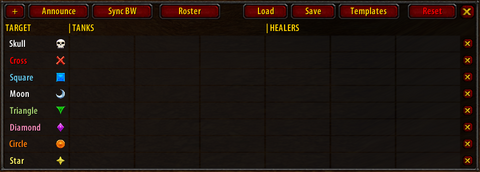TWAssignments
TWAssignments allows you to assign players to specific targets or tasks during raid encounters, enhancing coordination and communication within your team.
Installation
GitAddonsManager (Recommended)
The easiest way to keep TWAssignments up to date is by using GitAddonsManager.
- Add the Repository: Add the following URL to GitAddonsManager:
https://github.com/arvidinge/TWAssignments.git - Select the Branch: Ensure that the master branch is selected.
- Update: Using GitAddonsManager, you can check for and install updates for all your AddOns with a single click.
Manual Installation
If you prefer manual installation, follow these steps:
- Go to the main page of the repository.
- Click the <> Code dropdown and download the repository as a
.zip. - Unpack the
.zipand rename the folder toTWAssignments, removing the-mastersuffix. - Move the folder into your
Interface/AddOnsdirectory and restart the game.
Git Links
Basic Usage
- Open the main window by clicking the relevant button.
- To add an assignment row, click the
+button in the top-left corner:
- In the first column, select the target. In columns 2-4, assign tanks, and in columns 5-7, assign healers.
- Targets: Choose from raid markers (skull, cross, square, etc.), bosses, adds, or based on fight mechanics.
- Tanks: Assign any class as a tank.
- Healers: Assign players who play as druids, paladins, priests, and shamans.
- To select a player, click the cell and choose from the dropdown menu.
Example Assignment:
Let’s say you want to set up a fight with a boss and some adds. You would arrange your assignments accordingly:
- To announce your assignments in raid chat, simply click the
Announcebutton in the top left corner:
Note: These assignments cannot be saved and loaded again without using the templates feature.
Templates
Templates allow for preset assignments tailored for specific raid encounters (e.g., Molten Core, Blackwing Lair, Ahn'Qiraj, Naxxramas).
How to Use Templates
- Click the
Templatesbutton in the top right of the frame to access the dropdown. - Select the desired template, for example, the Gaar template for Molten Core:
- Assign players to the template as needed:
- To save your current assignments to the template, click the
Savebutton next to the template dropdown.
Note: Only player names are saved. Changes to row counts or target column values will not persist after a relog or UI reload.
Roster Management
Your roster is a list of players you frequently play with, enabling quick assignments without needing everyone to be in the raid at the same time.
Managing Your Roster
- Click the
Rosterbutton to open the roster window:
- To add a player, click
Add Player(s)in the respective class section. Enter their name(s) in the pop-up and clickDone. You can list multiple names, one per line. - The player will now appear in the roster and can be assigned accordingly.
Automatic Synchronization
TWAssignments synchronizes assignment tables, selected templates, and rosters among all members with the addon installed. The raid leader acts as the master node for synchronization. When players join, they request a full sync from the leader.
Important Notes:
- Duplicate names are removed within each class but allowed across different classes.
- The synchronization algorithm ensures fresh roster updates are communicated efficiently between players.
Preview
Features
TWAssignments primarily allows you to assign players to specific targets during a raid and announce these assignments in the raid chat. Here are some key points to remember:
- Raid Group Requirement: Changes can only be made while in a raid group, and only leaders or assistants can modify assignments.
- Leader Requirement: The raid leader must have TWAssignments installed to facilitate automatic synchronization between members.
- Version Compatibility: All assistants and leaders should use the same version of TWAssignments to ensure consistent behavior and communication.
For more details, refer to the section on Automatic Synchronization.
